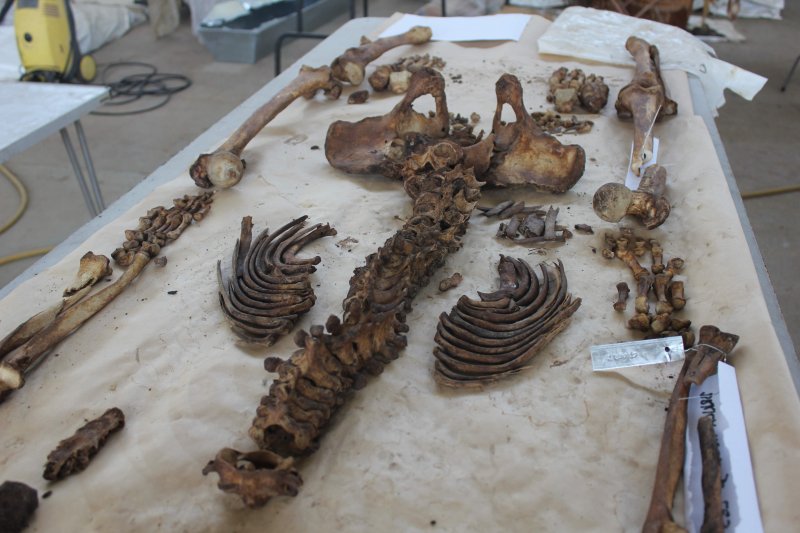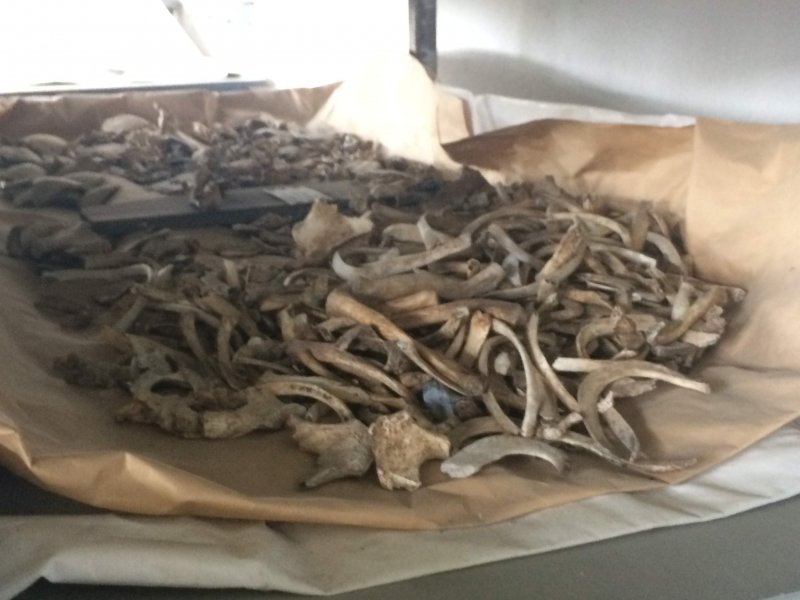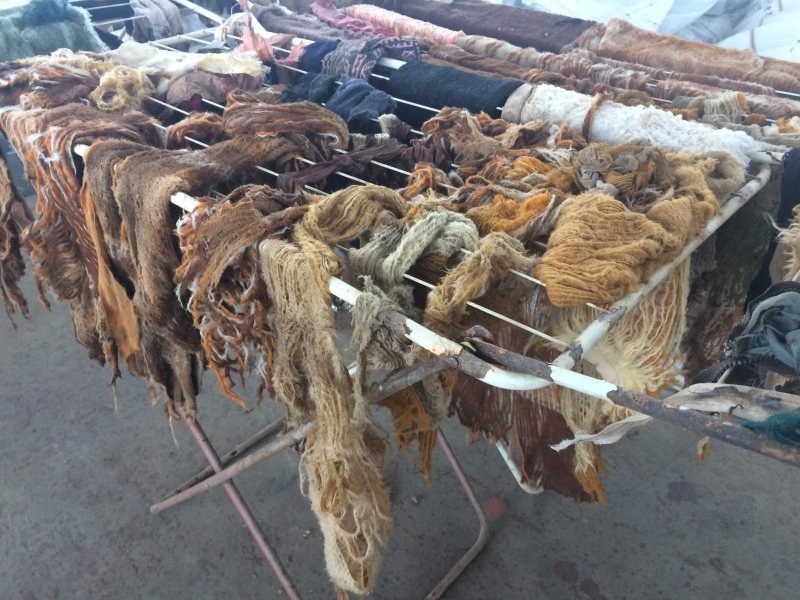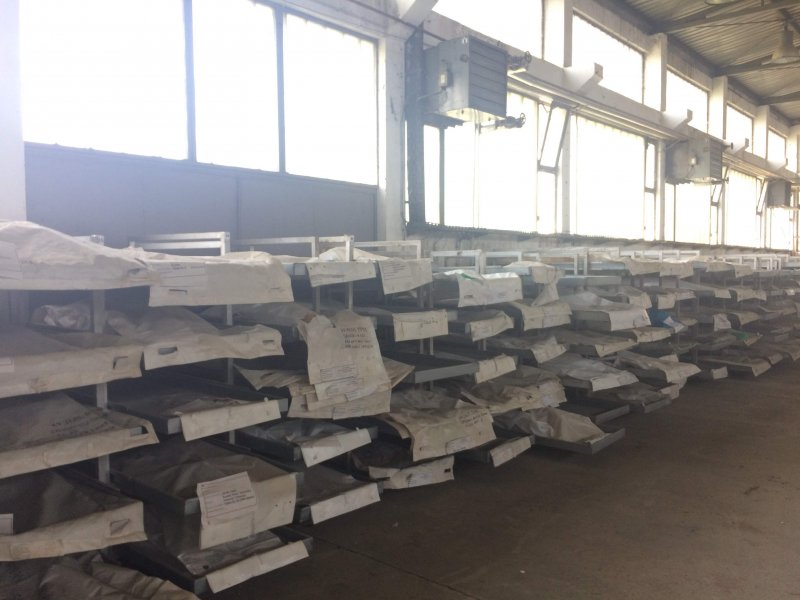D Sarzinski does not have a normal job. That becomes obvious in a warehouse smelling of dirt and dust, next to a cement factory on the outskirts of Sanski Most, a small town in northern Bosnia-Herzegovina.
Inside, lying on collapsible tables – the sort you might find at a village cake sale – are the bones of people killed in the 1992-1995 Bosnian conflict. Arranged on metal shelves around the walls, body bags are filled with thousands more teeth, skulls and human bones.
This is the Krajina Identification Project (KIP) facility, one of the centres where Sarzinski works as a forensic anthropologist for the International Commission on Missing Persons (ICMP). Since 1996, the organisation has assisted state authorities in Bosnia and Herzegovina with excavation and identification of war victims’ bodies.
Some of them were found in the mud and slush of mass graves. Other bodies were buried in forests or gardens. In the 1992-1995 conflict, in which the death toll reached 100,000, people died everywhere.

Photo: Lizzie Porter
By pushing for legislation to seek out and recognise the dead, the ICMP has helped to identify some 23,000 of the 30,000-plus people who went missing during the war. Most of them – some 15,000 individuals – have been identified using DNA matches with surviving relatives.
But for the past four years, Sarzinski and her colleagues have been painstakingly going through more than 3,000 sets of remains – piles of bones, skulls, teeth, clothes and other belongings – from graves which were exhumed years ago, but that somehow slipped through the system. The skeletons in Sanski Most are among these remains. In ten mortuaries around the country, Sarzinski’s team has found 101 new people.
“I am very proud of that number”, says Sarzinski. “That is 101 people who would otherwise not have been identified.”
It is not her job to pinpoint the cause of death – that is up to pathologists. Rather, she and her team develop profiles of who these piles of bones once were.
“You have these families who insist on coming [here] and seeing the remains,” she says. “You cannot prevent them from doing so because it’s their legal right. For some of them, it’s their closure.”
Once identified, victims are given dignified burials in proper graves, the latest of which happened on July 20, in the northern town of Prijedor.
Mirsad Duratović, president of the Prijedor ’92 association of detainees, has his own experience of burying missing relatives, after a decades-long search. He lost 47 family members before being taken to the Serb-run Omarska concentration camp, where 700 Bosnian Muslims were killed over three months in summer 1992.
“There were periods where they gave us no food or water for two days”, he told the New Statesman.
Through DNA matching, Duratović later found the bodies of three uncles who had been killed at Omarska in mass graves.

Photo: Lizzie Porter
“The search for them lasted 21 years”, he says. “I felt that finding them was more painful then losing them. Don’t get me wrong – losing your family hurts a lot – but trying to find them, just to know where they are, and not succeeding, hurts even more.”
Ethnic and nationalistic tensions have stood in the way of identifying the Bosnian conflict’s dead and missing. It took three years for the ICMP to obtain permission to operate in the Republika Srpska entity, a Serb-dominated region of Bosnia-Herzegovina. Authorities in the area claimed they already had mechanisms for identifying the missing, and did not need the help of a state-level institution.
“The argument was that the facilities are a very nice condition – which is completely true,” explains Nihad Branković, ICMP’s Western Balkans program officer, in an interview in his Sarajevo office. “But once we opened the body bags, then the main problem [of unidentified cases] is there.”
Critics have accused the ICMP of bias. According to Branković, death tolls are used as political tools to try to prove various actors’ roles in the Balkans conflict, which was characterised by sectarian and nationalistic divisions.
But the organisation takes what staff call an “ethnicity-blind” approach.
“The process of exhumation, the DNA- led identification are done under barcode, so in the lab we do not know at all [the victim’s ethnicity]”, says Branković. “Once we do have a match, once we do have a name, our forms do not indicate ethnicity because we don’t care and we don’t know. Names in Bosnian are fluid things, so someone with a Bosniak [Muslim] name could easily be another ethnicity.”
For the 8,000 people who remain missing, the future is uncertain.
Some are undoubtedly still under the earth, perhaps buried unfound in the folds of Bosnia-Herzegovina’s beautiful mountains. In June the ICMP launched an online application to tackle the lack of quality information on remaining clandestine or mass graves. Members of the public can submit information on possible locations anonymously, in the hope that it will lead to the identification of more missing persons.
There are also cases of mistaken identity. Before the introduction of DNA testing in 2001, thousands of people were identified visually: families would be invited to confirm a dead relative by way of clothes, features, size, and so on.
But the approach proved unreliable. In the moments before their deaths, people exchanged clothes and even ID cards. Families buried the remains of people they falsely believed to be their relatives.

Photo: Lizzie Porter
A blood collection drive will begin this September, in the hope of identifying mistaken burials through DNA matching. But it will have to be approached with the utmost delicacy.
“It’s an extremely difficult issue for the families who have thought that they’ve closed that chapter of their lives 20 years ago”, says Branković. “If you think that you’ve buried him or her and you think that you’ve found some sort of closure, and then someone knocks at your door and asks you for a blood sample. You say ‘Why? I’ve identified and buried my relative, why are you doing this?’ So we are afraid of this retraumatisation of the families once again.”
The other issue is physically tracking families down. Many Bosnians fled abroad during the war – according to the Bosnian Ministry of Human Rights and Refugees, the diaspora consists of 2 million people.
Funds are a perennial issue, although Branković insists that on an annual budget of around $4m, the ICMP can afford to finish projects underway.
Still, they are stretched: work at the Krajina Identification Project (KIP) facility in Sanski Most is on hold while Sarzinski’s team works in a mortuary elsewhere. The building is gathering dust and dirt, as the bones of the missing who lie here age.

Photo: Lizzie Porter
In Prijedor, Duratović says the local Serb-led authorities stifle efforts to support war survivors and families of the missing.
“They cut off our financing from the town budget in 2012,” he says. “We are being ignored. They are trying to silence us.”
There is also a question mark over what will happen to the rest of the missing when ICMP staff leave Bosnia-Herzegovina – a timeframe itself dependent on future donations. So far, 80 percent of the organisation’s funding comes from the EU, with Norway, the Netherlands, Sweden and Switzerland other major contributors.
Training in the fields of forensic anthropology, pathology and DNA testing is almost non-existent in Bosnia-Herzegovina – a bitter irony in a country that needs it so badly. Sarzinski herself went abroad for her higher education, gaining a BA from Bryn Mawr College in Pennsylvania, and an MSc in Forensic Anthropology from the University of Central Lancashire in the UK.
If Bosnia-Herzegovina is to ascend to the EU, authorities will have to support home-grown efforts to uncover the missing war dead. As Branković puts it: “The EU does not want to have Balkan states joining which still literally have skeletons in the closet.”
Yet issues slowing down the identification of Bosnia-Herzegovina’s missing remain immensely complex.
“While I was looking for my family every new piece of information gave me hope”, says Duratović, the Omarska concentration camp survivor. “For some, the search is still going.”







